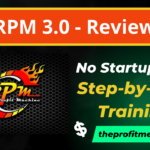Email marketing is a cornerstone of modern business promotion, and choosing the right email marketing platform is essential. AWeber and GetResponse are two of the most popular options available, each offering a range of features to help businesses connect with their audience effectively. In this article, we’ll explore the key factors to consider when deciding between AWeber and GetResponse to make the best choice for your business.
Proven Way to Make Money Online – Watch this FREE Video to START >>

Understanding Your Business Needs:
Before delving into the comparison, it’s important to understand your business’s specific needs and goals. Consider factors like your budget, the size of your email list, the complexity of your marketing campaigns, and the level of automation required. This initial self-assessment will guide your decision.
AWeber: A Closer Look:
AWeber has been a trusted name in email marketing for over two decades. Here are some of the platform’s key features:
1. User-Friendly Interface: AWeber is known for its simplicity and ease of use. It’s an excellent choice for beginners and those who want a straightforward email marketing solution.
2. Automation Tools: AWeber offers automation capabilities, including autoresponders, which allow you to send targeted emails based on subscriber actions. While not as robust as some other platforms, it’s sufficient for many businesses.
3. Landing Page Builder: AWeber recently introduced a landing page builder, making it easy to create landing pages for your campaigns.
4. Integration: AWeber integrates seamlessly with a wide range of third-party applications, ensuring you can connect with the tools you need.
5. Reliable Customer Support: AWeber is known for its strong customer support, offering assistance through various channels.
1. User-Friendly Interface
In the world of email marketing, user-friendliness can be a game-changer. AWeber, a well-established email marketing platform, has earned its reputation for providing businesses and marketers with an intuitive and user-friendly interface. In this article, we’ll explore how AWeber’s user-friendly design streamlines the email marketing process, making it an attractive choice for beginners and experienced users alike.
Why User-Friendliness Matters:
The success of an email marketing campaign hinges on various factors, including the ease of use of the chosen platform. A user-friendly interface not only simplifies the email creation process but also makes tasks like list management, automation, and reporting accessible to users of all skill levels. AWeber prioritizes this user-friendly approach, understanding its significance in the world of email marketing.
Key Aspects of AWeber’s User-Friendly Interface:
1. Simple Email Creation:
AWeber’s drag-and-drop email builder is designed with beginners in mind. Creating visually appealing emails is as straightforward as selecting content blocks, customizing text, images, and links, and arranging them to your liking. The process doesn’t require any coding knowledge, and the interface guides you through the email creation process seamlessly.
2. Automation Made Easy:
AWeber offers automation features, and its user-friendly interface ensures that setting up autoresponders and email sequences is a breeze. You can schedule emails, segment your list, and trigger messages based on subscriber behavior without the need for complex technical skills.
3. List Management:
Organizing and managing your subscriber list is a fundamental aspect of email marketing. AWeber’s interface simplifies list management tasks. You can easily add, remove, or segment subscribers, making it effortless to target specific groups with tailored content.
4. Intuitive Reporting:
To gauge the performance of your email campaigns, AWeber’s interface provides user-friendly reporting and analytics. Visual data representation and clear metrics allow you to track open rates, click-through rates, and other essential campaign data at a glance.
5. Integration with Third-Party Tools:
AWeber integrates seamlessly with numerous third-party applications, extending the functionality of the platform. Whether you need to connect with e-commerce, CRM, or social media tools, AWeber’s user-friendly interface ensures a hassle-free integration process.
Responsive Support:
AWeber’s user-friendly interface is complemented by its responsive customer support. Whether you’re a seasoned email marketer or a beginner, the platform offers reliable support through email, chat, and phone. Additionally, a wealth of resources, including knowledge bases, guides, webinars, and blog content, is readily available to assist users in navigating the platform effectively.
AWeber’s commitment to providing a user-friendly interface offers an accessible and efficient email marketing solution. Whether you’re new to email marketing or seeking a streamlined platform for your campaigns, AWeber’s intuitive design empowers users to create, automate, and manage their email marketing efforts with ease. Its user-friendliness paves the way for businesses and marketers to engage with their audience, drive conversions, and achieve email marketing success.
Proven Way to Make Money Online – Watch this FREE Video to START >>
2. Automation Tools
In the dynamic world of email marketing, automation tools have become invaluable assets for businesses and marketers. AWeber, a prominent email marketing platform, offers a suite of automation tools designed to simplify and enhance email campaigns. In this article, we will delve into the automation tools in AWeber, exploring how they empower businesses to streamline their email marketing efforts for maximum efficiency and effectiveness.
Automation Tools in AWeber:
AWeber’s automation tools are designed to help users create personalized, targeted, and timely email campaigns. Here are some key automation features in AWeber:
1. Autoresponders: Autoresponders are at the core of email automation. With AWeber, you can set up automated email sequences that are triggered by specific subscriber actions, such as joining your list, making a purchase, or clicking on a link. These sequences help nurture leads and engage with subscribers based on their behavior.
2. Tagging and Segmentation: AWeber allows users to tag subscribers based on their behavior and attributes. This tagging system simplifies list segmentation, enabling highly targeted and relevant email campaigns. For example, you can tag subscribers who have shown interest in a specific product and send them tailored offers.
3. Behavior-Based Triggers: AWeber’s automation allows for behavior-based triggers. You can create automated workflows that initiate when subscribers take specific actions, such as opening an email or clicking on a link. This feature enables timely follow-ups and personalization.
4. Custom Email Triggers: AWeber’s automation tool includes custom email triggers. You can specify conditions that must be met for a particular email to be sent, providing even more precise control over your campaigns.
5. Drip Campaigns: Drip campaigns are pre-scheduled email sequences designed to nurture leads over time. AWeber simplifies the creation of drip campaigns, enabling businesses to deliver content and messages to subscribers at the right intervals.
6. E-commerce Integration: For e-commerce businesses, AWeber’s automation tools can integrate with popular e-commerce platforms. This integration enables automated order confirmations, abandoned cart recovery emails, and customer feedback requests.
7. Personalization: Automation in AWeber allows for personalization through dynamic content. You can customize email content to cater to individual subscriber preferences, creating a more engaging and relevant experience.
Benefits of AWeber’s Automation Tools:
1. Efficiency: AWeber’s automation tools streamline tasks that would otherwise be time-consuming and manual. This efficiency allows marketers to focus on strategy and creative aspects of email marketing.
2. Personalization: Automation tools enable highly personalized campaigns, which are more engaging and effective in building customer relationships.
3. Consistency: Automated campaigns ensure emails are sent consistently and on schedule, maintaining subscriber engagement and trust.
4. Advanced Segmentation: AWeber’s automation simplifies list segmentation, allowing you to send targeted content to specific subscriber groups.
5. Data-Driven Decisions: AWeber’s automation features provide insights and analytics that help businesses make data-driven decisions to improve their email marketing efforts.
AWeber’s automation tools are a game-changer in email marketing, offering a range of features to simplify and enhance your campaigns. By leveraging these tools, businesses can save time, deliver personalized content, and engage with their audience in a highly targeted and efficient manner. Whether you’re an e-commerce business, a content creator, or a small business, AWeber’s automation tools empower you to take your email marketing to the next level, building stronger connections with your subscribers and driving results.
3. Landing Page Builder
In the realm of email marketing, a well-crafted landing page can make all the difference in converting leads into loyal customers. AWeber, a trusted name in email marketing, goes beyond just email campaigns by offering a powerful landing page builder. In this article, we will explore the significance of AWeber’s landing page builder and how it empowers businesses to create compelling and effective landing pages.
The Importance of Landing Pages:
Landing pages serve as the gateway to your email marketing success. These single-page websites are designed to capture the attention of visitors and encourage them to take specific actions, such as signing up for a newsletter, making a purchase, or downloading a resource. Well-optimized landing pages can significantly boost conversion rates and drive growth for your business.
AWeber’s Landing Page Builder:
AWeber’s landing page builder is a user-friendly tool designed to simplify the process of creating and deploying landing pages. Here’s how it empowers businesses:
1. Ease of Use: AWeber’s landing page builder is known for its simplicity. You don’t need to be a web designer or developer to create stunning landing pages. The intuitive drag-and-drop interface allows you to build pages effortlessly.
2. Customization: The builder offers a variety of templates to choose from, making it easy to find a design that suits your campaign’s goals. You can customize these templates with your branding elements, including logos, images, and color schemes.
3. Mobile Responsiveness: AWeber ensures that landing pages created with their builder are fully responsive, meaning they adapt seamlessly to different screen sizes. This is essential in today’s mobile-centric world.
4. Integration: Landing pages can be seamlessly integrated with your email marketing campaigns. AWeber’s builder simplifies the process of connecting your landing pages to your email lists for effective lead capture and follow-up.
5. Conversion Optimization: The landing page builder includes features designed to optimize conversions. You can add forms, buttons, and other elements to encourage visitors to take action. A/B testing is also available to fine-tune your landing pages for better results.
Use Cases for Landing Pages:
1. Lead Generation: Landing pages are ideal for collecting leads. You can offer valuable resources like e-books, whitepapers, or webinars in exchange for visitor contact information.
2. Product Sales: Businesses can use landing pages to showcase products or services and encourage immediate purchases.
3. Event Registration: Landing pages simplify the process of event registration, whether it’s for webinars, workshops, or conferences.
4. Announcements and Promotions: AWeber’s landing pages are perfect for announcing new products, services, or promotions. The builder allows you to create eye-catching pages that grab the attention of your audience.
AWeber’s landing page builder is a valuable addition to its email marketing platform, offering businesses a seamless way to create high-converting landing pages. Whether you’re aiming to generate leads, boost sales, promote an event, or make announcements, AWeber’s builder simplifies the process of creating effective landing pages. This tool empowers businesses to elevate their campaigns, engage with their audience, and drive conversions, ultimately contributing to email marketing success and business growth.
Proven Way to Make Money Online – Watch this FREE Video to START >>
4. Integration
In the world of email marketing, the ability to seamlessly connect with other essential tools and platforms is a game-changer. AWeber, a renowned email marketing solution, stands out for its robust integration capabilities. In this article, we will explore the significance of integration in email marketing and how AWeber empowers businesses to streamline their marketing efforts by connecting with various third-party tools.
The Role of Integration in Email Marketing:
Integration is the process of connecting your email marketing platform with other applications and systems, allowing data and information to flow between them. It plays a vital role in email marketing for several reasons:
1. Data Synchronization: Integration ensures that subscriber information, contact lists, and behavioral data are up-to-date across all connected platforms. This eliminates the risk of outdated or inconsistent data.
2. Automation: Integrated systems can trigger actions based on user behavior. For example, a purchase on your e-commerce platform can trigger an automated email in your email marketing platform, enhancing the customer journey.
3. Multi-Channel Marketing: Integration allows you to coordinate your marketing efforts across multiple channels. You can sync email marketing with social media, CRM, e-commerce, and more for a cohesive and effective marketing strategy.
4. Efficiency: Integrations streamline processes. For instance, integrating your email marketing platform with your CRM can save time by automating lead data capture and follow-ups.
AWeber’s Integration Capabilities:
AWeber offers a wide array of integrations that empower businesses to connect with their preferred tools and platforms. Some key aspects of AWeber’s integration capabilities include:
1. E-commerce Integration: AWeber integrates with popular e-commerce platforms like Shopify and WooCommerce. This integration enables businesses to sync customer data, track purchase behavior, and automate email follow-ups for abandoned carts or post-purchase emails.
2. CRM Integration: AWeber can be seamlessly integrated with various customer relationship management (CRM) systems, allowing businesses to centralize and manage customer data efficiently. This integration streamlines lead management and customer communication.
3. Content Management Systems (CMS): AWeber integrates with content management systems like WordPress, enabling businesses to embed sign-up forms and capture leads directly from their websites.
4. Social Media: AWeber’s integration with social media platforms allows businesses to connect their email marketing efforts with social media marketing. This integration facilitates cross-promotion and audience engagement.
5. Analytics: Integrating AWeber with analytics tools provides insights into email campaign performance. This helps businesses make data-driven decisions and optimize their email marketing strategies.
Use Cases for Integration:
1. E-commerce: Integrating AWeber with e-commerce platforms is ideal for businesses looking to boost sales through targeted email marketing, abandoned cart recovery emails, and post-purchase follow-ups.
2. Lead Generation: Businesses can integrate AWeber with lead generation tools to streamline the capture of leads from website forms, landing pages, and social media.
3. CRM Integration: AWeber’s CRM integration enhances lead and customer management, simplifying the process of nurturing leads and fostering better customer relationships.
4. Multi-Channel Marketing: Integrating AWeber with social media platforms allows businesses to sync their email marketing campaigns with their social media efforts, improving audience engagement.
Integration is a pivotal component of successful email marketing, and AWeber’s robust integration capabilities empower businesses to connect their email marketing with other critical tools and platforms. This streamlines data management, enhances automation, and supports multi-channel marketing efforts. By harnessing AWeber’s integration capabilities, businesses can optimize their marketing strategies, engage with their audience effectively, and drive growth in their email marketing campaigns.
5. Reliable Customer Support
In the fast-paced world of email marketing, having a reliable and responsive customer support team is invaluable. AWeber, a trusted name in email marketing, is renowned for its unwavering commitment to customer support. In this article, we will explore the importance of reliable customer support in email marketing and how AWeber’s dedicated support team empowers businesses to succeed.
The Vital Role of Customer Support:
Effective customer support is crucial in the realm of email marketing for several reasons:
1. Technical Assistance: Email marketing platforms can be complex. Businesses often require assistance with technical issues, integrations, and platform navigation.
2. Problem Resolution: When problems arise, businesses need prompt and effective solutions to minimize disruptions to their email marketing campaigns.
3. Onboarding and Training: Support teams help new users get started with the platform, offering guidance and training to maximize its potential.
4. Campaign Optimization: Customer support can offer advice on optimizing email campaigns for better engagement and conversion rates.
5. Responsive Assistance: Timely support ensures that businesses can continue their operations without significant downtime.
AWeber’s Commitment to Reliable Customer Support:
AWeber’s customer support team is known for its dedication to helping businesses succeed in email marketing. Key aspects of AWeber’s customer support excellence include:
1. Multi-Channel Support: AWeber offers support through various channels, including email, live chat, and phone support. Users can choose the channel that suits their preferences and needs.
2. Knowledge Base: AWeber provides a comprehensive knowledge base, offering articles, tutorials, and guides to help users navigate the platform effectively.
3. Webinars and Resources: The platform hosts webinars and offers a wealth of resources, including blog content and videos, to educate users on email marketing best practices.
4. 24/7 Availability: AWeber’s support team is available around the clock, ensuring users have access to assistance whenever they need it, regardless of their time zone.
5. Onboarding Assistance: AWeber’s onboarding process includes personalized assistance to help new users set up their accounts and get started with email marketing.
Use Cases for Customer Support:
1. Technical Issues: A responsive support team can swiftly address technical issues, ensuring that email marketing campaigns run smoothly.
2. Problem Resolution: Whether it’s a delivery issue, a template problem, or an integration challenge, customer support can efficiently resolve these issues.
3. Platform Training: AWeber’s customer support assists new users in getting acquainted with the platform, including setting up email lists, designing emails, and configuring automation.
4. Campaign Optimization: Support can provide guidance on optimizing email campaigns, including A/B testing, subject lines, and content strategies for better engagement and conversion rates.
5. Emergency Assistance: When issues require immediate attention, AWeber’s 24/7 availability ensures that businesses can receive help, even outside of regular business hours.
Customer support is a cornerstone of success in email marketing, and AWeber’s commitment to providing reliable support is a testament to its dedication to its users. Businesses can rely on AWeber’s multi-channel support, knowledge base, and 24/7 availability to address technical issues, optimize campaigns, and ensure their email marketing operations run smoothly. With AWeber’s support team by their side, businesses can navigate the complexities of email marketing, engage with their audience effectively, and achieve their email marketing goals.
Proven Way to Make Money Online – Watch this FREE Video to START >>
GetResponse: A Comprehensive Solution:
GetResponse is a versatile email marketing platform that provides a wide range of features for businesses. Here’s what sets it apart:
1. Robust Automation: GetResponse shines in the automation department. It offers advanced marketing automation features, allowing you to create intricate workflows and trigger emails based on subscriber behavior.
2. Email Creation: GetResponse’s email editor offers a variety of templates and advanced design options, making it ideal for those who want to create highly customized emails.
3. Webinar Hosting: One of GetResponse’s unique features is its webinar hosting capabilities. It allows you to host webinars directly from the platform, an excellent tool for engaging with your audience in real-time.
4. Landing Page Builder: GetResponse’s landing page builder is feature-rich, making it easy to create landing pages that convert.
5. Integration: Like AWeber, GetResponse integrates with a wide range of third-party apps, allowing you to connect with your preferred tools.
Proven Way to Make Money Online – Watch this FREE Video to START >>
1. Automation
In the dynamic world of digital marketing, automation has emerged as a driving force behind efficiency, engagement, and success. GetResponse, a leading marketing platform, offers a suite of automation tools that empower businesses and marketers to streamline their marketing efforts, deliver highly personalized campaigns, and engage with their audience effectively. In this article, we will explore the importance of automation in GetResponse and how it plays a pivotal role in shaping marketing strategies for businesses and marketers.
The Significance of Automation in Marketing:
Automation in marketing is the process of using technology and software to perform repetitive and manual marketing tasks with minimal human intervention. Here’s why automation is crucial in the modern marketing landscape:
1. Efficiency: Automation optimizes marketing processes, saving time and resources. It reduces the risk of errors and ensures tasks are completed consistently.
2. Personalization: Automated marketing allows for highly personalized and targeted campaigns. Automation tools track subscriber behavior and deliver messages based on individual actions and preferences.
3. Scalability: Automation is scalable, accommodating changes in workload and business growth. It enables businesses to expand and adapt their processes as needed.
4. Data-Driven Decisions: Automation provides access to real-time data, allowing businesses to make informed decisions based on accurate, up-to-date information.
5. Consistency: Automation ensures that marketing tasks are executed consistently and on schedule, leading to higher subscriber engagement and trust.
Key Automation Features in GetResponse:
1. Marketing Automation: GetResponse excels in marketing automation, offering advanced workflows, tagging, and scoring. Marketers can set up automation sequences triggered by subscriber behavior, ensuring highly personalized campaigns.
2. Email Templates: GetResponse provides a wide range of responsive email templates, simplifying the process of designing visually appealing emails. These templates are fully customizable to match your brand.
3. Webinar Hosting: A unique feature in GetResponse is its webinar hosting capabilities. Marketers can host webinars directly from the platform, engaging with their audience in real-time.
4. Landing Page Builder: GetResponse’s landing page builder allows businesses to create high-converting landing pages. These pages seamlessly integrate with email marketing efforts.
5. A/B Testing: GetResponse includes A/B testing features, enabling marketers to experiment with different email elements and strategies to optimize their campaigns.
Use Cases for GetResponse Automation:
1. Lead Nurturing: With GetResponse automation, businesses can set up lead nurturing workflows that guide leads through the sales funnel, delivering relevant content at the right time.
2. Drip Campaigns: Drip campaigns, a series of pre-scheduled emails, are easily created in GetResponse to maintain consistent engagement with leads.
3. Behavior-Based Triggers: Automation in GetResponse can initiate workflows based on subscriber behavior, such as email opens, clicks, or website visits, enabling timely follow-ups.
4. Segmentation: Advanced list segmentation is crucial for targeted campaigns. GetResponse’s automation features simplify the process of segmenting subscribers based on their behavior and attributes.
5. Event Triggered Emails: GetResponse’s automation handles event-triggered emails, such as birthday wishes, purchase confirmations, and order shipping notifications.
GetResponse’s automation tools are a game-changer in the world of digital marketing. By implementing comprehensive automation solutions, businesses and marketers can enhance efficiency, reduce costs, deliver highly personalized campaigns, and achieve their marketing objectives. GetResponse’s dedication to automation empowers users to engage with their audience effectively, drive conversions, and ultimately contribute to their long-term growth and success in the competitive digital marketing landscape.
Proven Way to Make Money Online – Watch this FREE Video to START >>
2. Email Creation
In the world of email marketing, the art of creating compelling and engaging emails is pivotal to achieving campaign success. GetResponse, a leading marketing platform, equips businesses and marketers with powerful tools to craft emails that captivate their audience. In this article, we’ll explore the importance of email creation and how GetResponse empowers users to design, personalize, and send emails that drive results.
The Significance of Email Creation:
Emails are the backbone of your digital marketing strategy. They are the primary channel through which you connect with your audience, deliver your brand’s message, promote products or services, and nurture customer relationships. Effective email creation encompasses several critical elements:
1. Design: Visually appealing emails are more likely to capture the reader’s attention. A well-designed email with an attractive layout, eye-catching images, and a consistent color scheme contributes to the overall design.
2. Content: The content of your email, including text and images, must be engaging and relevant. Your copy should be concise, compelling, and tailored to the audience’s needs and preferences.
3. Personalization: Personalization enhances engagement. GetResponse offers tools for dynamic content and personalization based on subscriber data, such as first names and past interactions.
4. Mobile Responsiveness: In the era of mobile browsing, emails must be mobile-responsive to ensure they render correctly on various devices, including smartphones and tablets.
5. Call to Action (CTA): Every email should feature a clear and compelling CTA that guides readers to take the desired action, whether it’s making a purchase, signing up for a newsletter, or downloading a resource.
GetResponse’s Email Creation Features:
1. Email Templates: GetResponse provides a rich selection of responsive email templates. These templates are professionally designed and fully customizable, enabling you to align them with your brand’s identity and messaging.
2. Drag-and-Drop Editor: GetResponse’s drag-and-drop editor simplifies the email creation process. Users can effortlessly add and arrange content blocks, customize text, images, buttons, and more, all without requiring any coding skills.
3. Dynamic Content: Personalization is made easy with GetResponse’s dynamic content feature. Users can create content that adapts based on the subscriber’s data, such as location or past interactions with your emails.
4. Mobile-Responsive Design: GetResponse ensures that emails created with its platform are mobile-responsive, guaranteeing a seamless reading experience on various devices.
5. A/B Testing: GetResponse includes A/B testing capabilities, allowing users to experiment with different email elements and strategies to determine what resonates most with their audience.
Use Cases for GetResponse’s Email Creation Features:
1. Promotional Emails: GetResponse’s email creation tools are ideal for designing visually appealing promotional emails that showcase products, services, or special offers.
2. Newsletter Campaigns: Users can create newsletters that feature valuable content and updates, keeping subscribers informed and engaged.
3. Welcome Emails: GetResponse empowers businesses to send welcoming emails to new subscribers, introducing them to the brand and setting expectations.
4. Drip Campaigns: Drip campaigns involve sending a series of pre-scheduled emails. GetResponse’s email creation tools make it easy to design these campaigns, delivering content at the right intervals to nurture leads.
5. Event Announcements: Businesses can use GetResponse to create and send event announcements, whether they’re for webinars, product launches, or special events.
GetResponse’s email creation features are the cornerstone of email marketing success. By providing a user-friendly drag-and-drop editor, dynamic content capabilities, mobile-responsive designs, and a diverse selection of templates, GetResponse empowers users to craft engaging and effective emails. Whether you’re promoting products, sending newsletters, welcoming new subscribers, or announcing events, GetResponse’s tools ensure that your emails captivate your audience, drive engagement, and achieve your email marketing goals.
3. Webinar Hosting
In the world of digital marketing, webinars have emerged as a dynamic and interactive way to engage with your audience, educate them, and drive business growth. GetResponse, a leading marketing platform, goes beyond email marketing by offering powerful webinar hosting capabilities. In this article, we will delve into the significance of webinar hosting and how GetResponse empowers businesses and marketers to connect with their audience effectively through webinars.
The Power of Webinars in Marketing:
Webinars, short for web seminars, are live, online presentations or events that allow businesses to connect with their audience in real time. They offer several key benefits:
1. Engagement: Webinars are highly engaging and interactive, allowing presenters to connect with their audience through live video, chat, and Q&A sessions.
2. Education: Webinars provide a platform for businesses to educate their audience about their products, services, or industry-related topics, positioning them as experts.
3. Lead Generation: Webinars are a powerful tool for lead generation. Attendees often provide contact information to register, allowing businesses to follow up with potential leads.
4. Relationship Building: Webinars create opportunities for businesses to foster deeper relationships with their audience by addressing their questions and concerns in real time.
5. Data and Insights: Webinar hosting platforms provide valuable data and insights, including attendance rates, engagement levels, and audience feedback.
GetResponse’s Webinar Hosting Features:
1. User-Friendly Interface: GetResponse’s webinar hosting platform offers a user-friendly interface that simplifies the process of setting up and hosting webinars. You don’t need to be a tech expert to get started.
2. Customizable Registration Pages: GetResponse allows users to create customized registration pages for their webinars, ensuring a seamless and branded registration process for attendees.
3. Live and On-Demand Webinars: Users can host live webinars to engage with their audience in real time. Additionally, GetResponse enables the recording of webinars for on-demand access, reaching a broader audience.
4. Interactive Tools: GetResponse’s webinar hosting includes interactive features such as chat, polls, and Q&A sessions to engage with attendees and gather feedback.
5. Analytics and Insights: GetResponse provides detailed analytics and insights about webinar performance, including attendee engagement, attendance rates, and other key data points.
Use Cases for GetResponse’s Webinar Hosting:
1. Product Demonstrations: Businesses can host webinars to demonstrate their products or services, providing potential customers with a firsthand look at what they offer.
2. Educational Webinars: Webinars can be used for educational purposes, such as workshops, training sessions, or industry insights.
3. Lead Generation: Webinars serve as an effective tool for lead generation. Businesses can gather contact information from registrants and follow up with leads after the webinar.
4. Q&A Sessions: Webinars are an ideal platform for hosting Q&A sessions, addressing customer inquiries, and building trust.
5. Content Distribution: Webinar recordings can be repurposed as on-demand content, providing ongoing value to your audience.
GetResponse’s webinar hosting capabilities are a valuable addition to its marketing platform, providing businesses and marketers with the tools to engage with their audience effectively through live and on-demand webinars. Whether you’re looking to showcase products, educate your audience, generate leads, host Q&A sessions, or distribute valuable content, GetResponse’s webinar hosting empowers you to create meaningful connections with your audience, position your brand as an authority, and drive business growth through interactive and engaging webinars.
Proven Way to Make Money Online – Watch this FREE Video to START >>
4. Landing Page Builder
In the realm of digital marketing, landing pages play a pivotal role in converting visitors into leads and customers. GetResponse, a leading marketing platform, takes landing page creation to the next level with its powerful and user-friendly landing page builder. In this article, we will explore the significance of landing pages and how GetResponse empowers businesses and marketers to create stunning and high-converting landing pages.
The Importance of Landing Pages:
Landing pages are single web pages designed with a specific goal in mind, such as capturing leads, promoting a product, or encouraging a visitor to take a particular action. Here’s why they are essential:
1. Conversion Focus: Landing pages are tailored to a specific objective, making them highly effective at converting visitors into leads or customers.
2. Simplicity: They are free from distractions like navigation menus, ensuring that visitors stay focused on the page’s purpose.
3. Data Collection: Landing pages are ideal for collecting visitor data through forms, enabling businesses to build their email lists and learn more about their audience.
4. A/B Testing: Landing pages can be A/B tested to optimize their design and content for maximum conversion rates.
5. Lead Nurturing: They are a key component of lead nurturing campaigns, providing a platform to deliver valuable content and engage with potential customers.
GetResponse’s Landing Page Builder:
GetResponse’s landing page builder is a user-friendly tool designed to simplify the process of creating and deploying landing pages. Here’s how it empowers businesses and marketers:
1. Ease of Use: GetResponse’s landing page builder is known for its simplicity. You don’t need to be a web designer or developer to create stunning landing pages. The intuitive drag-and-drop interface allows you to build pages effortlessly.
2. Customization: The builder offers a variety of templates to choose from, making it easy to find a design that suits your campaign’s goals. You can customize these templates with your branding elements, including logos, images, and color schemes.
3. Mobile Responsiveness: GetResponse ensures that landing pages created with their builder are fully responsive, meaning they adapt seamlessly to different screen sizes. This is essential in today’s mobile-centric world.
4. Integration: Landing pages can be seamlessly integrated with your email marketing campaigns. GetResponse’s builder simplifies the process of connecting your landing pages to your email lists for effective lead capture and follow-up.
5. Conversion Optimization: The landing page builder includes features designed to optimize conversions. You can add forms, buttons, and other elements to encourage visitors to take action. A/B testing is also available to fine-tune your landing pages for better results.
Use Cases for GetResponse’s Landing Page Builder:
1. Lead Generation: Landing pages are ideal for collecting leads. You can offer valuable resources like e-books, whitepapers, or webinars in exchange for visitor contact information.
2. Product Sales: Businesses can use landing pages to showcase products or services and encourage immediate purchases.
3. Event Registration: Landing pages simplify the process of event registration, whether it’s for webinars, workshops, or conferences.
4. Announcements and Promotions: GetResponse’s landing pages are perfect for announcing new products, services, or promotions. The builder allows you to create eye-catching pages that grab the attention of your audience.
GetResponse’s landing page builder is a valuable addition to its marketing platform, offering businesses a seamless way to create high-converting landing pages. Whether you’re aiming to generate leads, boost sales, promote an event, or make announcements, GetResponse’s builder simplifies the process of creating effective landing pages. This tool empowers businesses and marketers to elevate their campaigns, engage with their audience, and drive conversions, ultimately contributing to marketing success and business growth.
5. Integration
In the realm of digital marketing, the ability to seamlessly connect with other essential tools and platforms is a game-changer. GetResponse, a leading marketing platform, stands out for its robust integration capabilities. In this article, we will explore the significance of integration in digital marketing and how GetResponse empowers businesses to streamline their marketing efforts by connecting with various third-party tools.
The Role of Integration in Digital Marketing:
Integration is the process of connecting your marketing platform with other applications and systems, allowing data and information to flow between them. It plays a vital role in digital marketing for several reasons:
1. Data Synchronization: Integration ensures that customer and subscriber information, contact lists, and behavioral data are up-to-date across all connected platforms. This eliminates the risk of outdated or inconsistent data.
2. Automation: Integrated systems can trigger actions based on user behavior. For example, a purchase on your e-commerce platform can trigger an automated email campaign in your marketing platform, enhancing the customer journey.
3. Multi-Channel Marketing: Integration allows you to coordinate your marketing efforts across multiple channels. You can sync your marketing platform with social media, CRM, e-commerce, and more for a cohesive and effective marketing strategy.
4. Efficiency: Integrations streamline processes. For instance, integrating your marketing platform with your CRM can save time by automating lead data capture and follow-ups.
5. Data Insights: Integration provides access to valuable data insights, enabling businesses to make data-driven decisions and optimize their marketing strategies.
GetResponse’s Integration Capabilities:
GetResponse offers a wide array of integrations that empower businesses to connect with their preferred tools and platforms. Some key aspects of GetResponse’s integration capabilities include:
1. E-commerce Integration: GetResponse integrates with popular e-commerce platforms like Shopify and WooCommerce. This integration enables businesses to sync customer data, track purchase behavior, and automate email follow-ups for abandoned carts or post-purchase emails.
2. CRM Integration: GetResponse can be seamlessly integrated with various customer relationship management (CRM) systems, allowing businesses to centralize and manage customer data efficiently. This integration streamlines lead management and customer communication.
3. Content Management Systems (CMS): GetResponse integrates with content management systems like WordPress, enabling businesses to embed sign-up forms and capture leads directly from their websites.
4. Social Media: GetResponse’s integration with social media platforms allows businesses to connect their email marketing efforts with social media marketing. This integration facilitates cross-promotion and audience engagement.
5. Analytics: Integrating GetResponse with analytics tools provides insights into email campaign performance. This helps businesses make data-driven decisions and optimize their email marketing strategies.
Use Cases for Integration:
1. E-commerce: Integrating GetResponse with e-commerce platforms is ideal for businesses looking to boost sales through targeted email marketing, abandoned cart recovery emails, and post-purchase follow-ups.
2. Lead Generation: Businesses can integrate GetResponse with lead generation tools to streamline the capture of leads from website forms, landing pages, and social media.
3. CRM Integration: GetResponse’s CRM integration enhances lead and customer management, simplifying the process of nurturing leads and fostering better customer relationships.
4. Multi-Channel Marketing: Integrating GetResponse with social media platforms allows businesses to sync their email marketing campaigns with their social media efforts, improving audience engagement.
Integration is a pivotal component of successful digital marketing, and GetResponse’s robust integration capabilities empower businesses to connect their marketing platform with other critical tools and platforms. This streamlines data management, enhances automation, and supports multi-channel marketing efforts. By harnessing GetResponse’s integration capabilities, businesses can optimize their marketing strategies, engage with their audience effectively, and drive growth in their digital marketing campaigns.
Proven Way to Make Money Online – Watch this FREE Video to START >>
Making the Decision:
When deciding between AWeber and GetResponse, consider the following:
1. Ease of Use: AWeber’s simplicity makes it an attractive option for beginners. GetResponse, while more powerful, may require a steeper learning curve.
2. Budget: Pricing varies depending on your list size and specific needs. AWeber can be more cost-effective for smaller lists, while GetResponse may offer more competitive pricing for larger lists or advanced features.
3. Automation: GetResponse is the clear winner in terms of automation capabilities, which is beneficial for businesses requiring complex marketing automation.
4. Webinar Hosting: If hosting webinars is a priority for your business, GetResponse offers this feature, while AWeber does not.
5. Customer Support: AWeber is known for its reliable customer support, which can be a significant advantage for businesses needing assistance.
Proven Way to Make Money Online – Watch this FREE Video to START >>
Conclusion:
Ultimately, the choice between AWeber and GetResponse depends on your business’s unique needs and goals. Take the time to assess your requirements, budget, and level of expertise, and consider the strengths and weaknesses of each platform. Both AWeber and GetResponse are respected email marketing solutions, but the best choice for your business will be the one that aligns most closely with your specific objectives and priorities.











